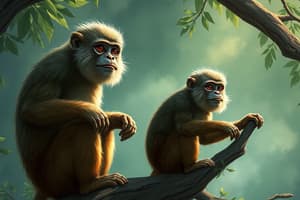Podcast
Questions and Answers
What is arboreal locomotion?
What is arboreal locomotion?
- The locomotion of animals in caves
- The locomotion of animals in deserts
- The locomotion of animals in water
- The locomotion of animals in trees (correct)
What are some mechanical challenges posed by arboreal habitats?
What are some mechanical challenges posed by arboreal habitats?
- Moving on narrow branches, running on plains, and burrowing in soil
- Moving on narrow branches, climbing mountains, and flying in the sky
- Moving on narrow branches, swimming in water, and digging underground
- Moving on narrow branches, crossing gaps, and dealing with obstructions (correct)
Which animal is exclusively arboreal in habitat?
Which animal is exclusively arboreal in habitat?
- Desert tortoise
- Polar bear
- Plains zebra
- Tree snail (correct)
What are the consequences of arboreal habitats for animals?
What are the consequences of arboreal habitats for animals?
Where else can the principles of arboreal locomotion be applied?
Where else can the principles of arboreal locomotion be applied?
Flashcards are hidden until you start studying
Study Notes
Arboreal Locomotion
- Movement through trees.
- Adaptations:
- Strong grasping limbs and flexible joints.
- Opposable thumbs for enhanced grip.
- Prehensile tails for balance and support.
- Enhanced visual perception for navigating branches.
Mechanical Challenges of Arboreal Habitats
- Branch Stability: Branches can be unstable, requiring specialized grip and balance adaptations.
- Verticality: Climbing vertical surfaces requires high muscle strength and specialized foot anatomy.
- Gap Crossing: Navigating between branches necessitates leaps and jumps, demanding powerful muscle coordination.
- Weight Support: Trees have limited load-bearing capacity, necessitating lightweight body structures and specialized adaptations.
Exclusively Arboreal Animals:
- Sloth: A mammal known for its slow, deliberate movements, adapted specifically for life in trees.
Consequences of Arboreal Habitats
- Specialized Adaptations: Animals develop unique anatomical features to thrive in tree-dwelling environments.
- Habitat Specificity: Arboreal habitats limit species distribution and resource availability, shaping evolutionary pathways.
- Predator-Prey Dynamics: Tree-dwelling environments offer refuge from predators, but also present unique challenges for hunting and foraging.
Applying Principles of Arboreal Locomotion
- Robot Design: Concepts of grasping limbs and flexible movement are applied in robotics for manipulating objects and traversing complex environments.
- Biomechanics and Human Movement: Understanding arboreal adaptations provides insights for developing rehabilitative therapies and improving human performance.
- Architecture and Design: Principles of weight distribution, strength, and balance are applied in structural design for buildings and bridges.
Studying That Suits You
Use AI to generate personalized quizzes and flashcards to suit your learning preferences.




